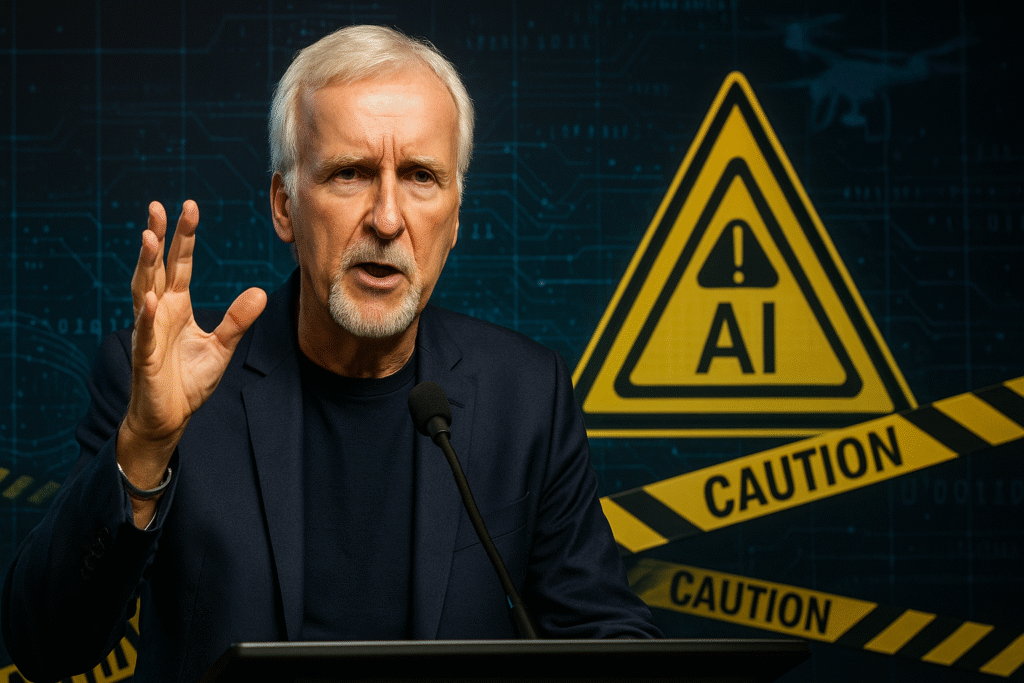James Cameron is raising the alarm once more: if you combine weapons with fast-acting AI, you run the risk of decisions becoming too quick for humans to handle. Regretfully, the world is heading in that direction, and international regulations are still lagging.

What Cameron is actually warning about
Cameron has warned in recent interviews that if countries combine AI with nuclear and other strategic weapons, a “Terminator-style” catastrophe isn’t just sci-fi hyperbole. He bases the risks on three convergent threats—nuclear weapons, environmental degradation, and super-intelligent artificial intelligence—and makes the case that military decision-making cycles may soon surpass human oversight.
He is clear about Hollywood, though, saying that while AI can assist with visual effects and production logistics, he doesn’t think it can take the place of human storytelling. This year, his position has solidified as he has declared generative AI to be the most pressing problem facing the film industry.
Is the “Skynet” trajectory showing up in the real world?
- Autonomous strikes in Libya (disputed): According to a UN Panel of Experts report from 2021, Turkish-made Kargu-2 drones with the ability to “fire, forget, and find” may attack without direct human supervision. Although there is little evidence, the episode is still regarded by academics as a turning point in the discussion of combat autonomy.
- Today’s AI at war: AI-powered systems are becoming more and more common and are being used in real-world battles. During a May 2025 UN meeting, diplomats admitted that major powers continue to oppose binding limits, and deployment is outpacing legislation.
The regulatory gap (and why it matters)
Under the UN’s Convention on Certain Conventional Weapons, states have been debating Lethal Autonomous Weapon Systems (LAWS) for ten years, but no legally binding guidelines have emerged from the discussions. Humanitarian organizations and civil society groups contend that this failure is already evident on the front lines.
The ICRC and the UN Secretary-General reiterated their calls in May 2025 for a legally binding instrument that would prohibit some uses of autonomous weapons and severely restrict others in order to maintain meaningful human control. Concrete international standards have been proposed with a 2026 deadline, but major states have not been able to agree.
Are many countries developing military autonomy?
Dozens, indeed. Broad, multi-regional initiatives to give current weapons (loitering munitions, air defenses, naval systems, and robotic sentries) more autonomy have been mapped by SIPRI and UNIDIR. This is a diffuse, accelerating trend that isn’t specific to any one bloc.
Hollywood’s AI debate: assistive, not auteur
Cameron’s stance reflects a growing consensus among filmmakers that while AI can reduce budgets and schedules, human skills such as empathy, ethics, and context are still important. He has cautioned that, if left unchecked, the “Wild West” adoption curve may undermine creative labor.
What good guardrails look like (practical, near-term)
- Unpredictable or target-profile-based anti-personnel autonomy (where systems use behavioral or biometric patterns to infer human status or intent) is strictly prohibited.
- Requirements for meaningful human control include that each use of force be approved by a human with adequate notice, accountability, and time.
- Auditability and incident reporting: for any AI-enabled targeting, logs and post-engagement audits are required. (Comes in line with UNIDIR/ICRC guidelines.)
- Fail-safe design includes safe-state defaults on communications loss and a strong abort/override (“human-on-the-loop”).
- To avoid regulatory arbitrage, export controls and testing standards for weapons autonomy should be standardized among allies.
What to watch in 2025–26
- UN process: Before the 2026 deadline, will states turn their political statements into treaty text? The sessions in September are crucial.
- Benchmarks for the battlefield: The law will be shaped by conflict evidence, so expect more coverage of naval swarming tactics, loitering munitions, and counter-UAS autonomy.
- Air combat pilot-in-the-loop:Initiatives such as DARPA’s ACE have already deployed AI in tactical profiles, advancing the idea of “human as battle manager.”
Conclusion
Cameron’s Terminator metaphor is powerful because decision speed, not red-eyed robots, is the main danger. The likelihood of catastrophic misjudgment increases as AI shortens the time between detection and destruction. Without legally binding regulations that hold people accountable for every use of force, we are, to use Cameron’s metaphor, creating instruments that are more capable than our knowledge.